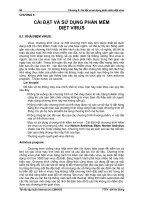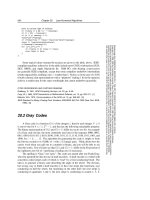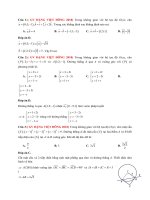Cs224W 2018 68
Bạn đang xem bản rút gọn của tài liệu. Xem và tải ngay bản đầy đủ của tài liệu tại đây (4.9 MB, 9 trang )
A network analysis of the Litecoin
blockchain
Marco Monteiro
Stanford University
Toby Bell
Stanford University
Abstract
Today Litecoin is the ninth-ranked cryptocurrency with a market cap of $1.5
billion. In this paper constructs and analyzes two network representations of the
blockchain. The first is a user-centric approach that represents user addresses as
vertices, and payments between users as edges. The second captures the non
fungibility of Litecoin, representing transactions as vertices, and the flow
between them as vertices. We discover roles in the user graph, assigning high
degree nodes to merchants and exchanges, and low degree nodes to ordinary
users. In analyzing the transaction graph we see payments are sparse and
irregular, and most importantly not representative of a real economy.
1
Introduction
Litecoin is an altcoin—a spinoff of the well-known cryptocurrency Bitcoin—that self-markets as
being a cryptocurrency for more lightweight user-to-user payments. It was launched on October 7,
2011 by Charlie Lee, as a fork of the Bitcoin source code with only a few small changes aimed at
making it better suited to its stated purpose of lightweight payments. Today, the collective market
cap of Litecoin is $1.5 billion, making it the ninth-ranked cryptocurrency at the time of writing.
Since, like Bitcoin and many other altcoins, all transaction data on the Litecoin blockchain is
publicly available, its economic behavior constitutes a ripe target for analysis.
In this paper we perform a network analysis of the Litecoin blockchain with two primary goals.
The first is to assess the development of the Litecoin currency over time, from when it started in
2011 to the present day in 2018. The second is to compare patterns of economic behavior on the
Litecoin blockchain to those of “real” currencies and economies, and assess the current state of
Litecoin as a viable monetary instrument. We initially had a third goal of de-anonymizing the
network as other work has done for other cryptocurrencies [3] [4] [5], but we ultimately decided
that data was not available today for Litecoin. Regarding these two goals, we note that we are
neither cryptocurrency experts nor economists, and in many ways our analysis is incomplete.
However, we leave many avenues for future work, lead among which is a comparison between the
graphical roles of Litecoin addresses and the real-world economic roles of their users.
2
Background
This paper analyzes the Litecoin blockchain from two perspectives: a user-centric perspective and
a transaction-centric perspective. In this section we provide a cursory technical explanation of
Litecoin, including definitions of several relevant terms, and then we precisely define these two
perspectives as two different graph projections of the blockchain.
Litecoin is a currency, and it is denoted by the symbol L. It can be held and exchanged in amounts
as small as £0.00000001—one one hundred millionth of a Litecoin, or one Litoshi. Because it is a
cryptocurrency, Litecoin has no physical cash, and it is held and exchanged exclusively digitally.
The Litecoin network is a computer network of connected devices that collectively facilitate the
secure operation of the Litecoin currency. These computers constantly communicate using a
common protocol with a distributed, peer-to-peer network topology. Though we will soon define
the blockchain as one of the core pillars of this protocol, its precise cryptographic details are not
relevant to this paper, and for this work it is sufficient to understand that in following this protocol,
the Litecoin network ensures the usefulness of Litecoin as a monetary instrument.
The Litecoin blockchain (or simply the blockchain) is a public data structure describing every
Litecoin transaction that has ever occurred. Every computer in the Litecoin network stores and
verifies its own separate copy of the blockchain. The Litecoin protocol ensures that all of these
copies remain identical as new transactions occur, thus justifying the term the blockchain. As with
the Litecoin protocol, the cryptographic details of the blockchain are not important for this paper,
other than to note that its design makes it almost impossible for a bad actor to modify it
retroactively. This means that no one can spend money they don’t have, or retrieve or re-spend
money they spent in the past (known as a double-spend). The current size of the blockchain is
about 20 GB.
A Litecoin address is similar to a bank account number, in that it uniquely identifies a monetary
account. An example of a Litecoin address is MTvnA4CN73ry7c65wEuTSakzb2pNKHB4n1.
Addresses are recorded in the blockchain as the recipients of transactions, and the set of unspent
transactions paid to a given address determines that address’s balance. Although in general one can
expect a loose correlation between Litecoin users and addresses, there is no hard correspondence.
A single user can create and use multiple addresses, and multiple users can agree to share a single
address. Since the blockchain stores addresses instead of user identities, in this paper we will use
an address-centric view of the blockchain to approximate a user-centric one.
Finally, a transaction on the Litecoin blockchain is a statement of the transfer of funds. Each
transaction lists one or more inputs from which it draws funds, and one or more outputs to which it
sends funds. Each output specifies a recipient user (via their address) and a value to pay them, and
each input must refer to an unspent output of a previous transaction. The sum of the values of a
transaction’s inputs must equal the sum of the values of its outputs. For an example, imagine Alice
pays Bob L10 one morning, and Bob pays Carol L5 that afternoon using the funds he received
from Alice. Let us refer to these two transactions as T; and T}, respectively. In this case, JT; might
specify a single output O, = (Bob, 10.0) that declares the transfer of L10 to Bob (note that 7;
must have also specified one or more inputs to fund this transfer). Then T, would specify a
reference to O, as its single input, and it would specify an output O = (Carol, 5.0) paying LS5 to
Carol. However, the sum of a transaction’s outputs must equal the sum of its inputs, so T, would
additionally specify an output O3 = (Bob, 5.0) paying the remainder of the funds back to Bob
himself. This interaction is illustrated in Figure 1. Finally, note that if Bob were now to attempt to
issue another transaction funded by O, (i.e., perform a double-spend), the Litecoin network would
reject it, since O, has already been spent by 7).
Figure 1: Illustration of a multi-transaction exchange between three users. The
light gray vertices simply represent the “one or more inputs” needed for 7}.
Having defined the blockchain, addresses, and transactions, we proceed to our economic network
analysis of Litecoin.
3
Methods
3.1.
Graph representation
The full structure of the blockchain is quite complex, and even more complex than the structure
portrayed in Figure 1, since transactions are further bundled into a Merkle list of connected blocks
that are added to the chain over time. Given this, for our work it is necessary to create a simplified
model of the blockchain that is better suited to network analysis.
We represent the blockchain as a bipartite directed graph of transactions and addresses. The
transactions and addresses form the vertices of the graph, and we use directed edges to indicate
relationships between them. In particular, an edge from a transaction to an address indicates that
the transaction paid at least one output to that address. Similarly, an edge from an address to a
transaction indicates that the transaction sourced at least one input from that address. An example
of such a graph for the scenario above is shown in Figure 2. This graph, called the transaction—
address graph, is a significant simplification of the blockchain, but at the cost of completeness we
gain ease of analysis. From this graph model we derive two projections, which we then use for our
network analysis of Litecoin.
(Alice
> T; —>( Bob LI T; —>( Carol ))
Figure 2: The transaction—address graph for the scenario from Figure 1.
We mentioned previously that we seek to analyze the Litecoin blockchain from two perspectives: a
user-centric perspective and a transaction-centric perspective. To this end we create two directed
bipartite network projections from the aforementioned transaction—address graph. The first is the
address graph, defined as a directed graph of addresses, where an edge (A;, A>) indicates that
there was at least one transaction T; with edges (Ay, T;) and (T;, A>) in the transaction—address
graph. Since we think of addresses more or less as users, this is effectively equivalent to a “call
graph” or communication graph in the directed social network setting. Formally, the address graph
may include self-edges, since paying an arbitrary amount to someone will almost always require
paying a remainder back to oneself. However, these edges tend not to be particularly meaningful
and in practice we often ignore them.
Figure 3: The address graph for the scenario from Figure 1.
The second graph projection we use for analysis is the transaction graph, defined as a directed
graph on Litecoin transactions where an edge (7, T>) indicates that an output of 7; was used as
an input of 75. This graph captures the non-fungibility of Litecoin and the flow of funds through
the network, since each transaction is funded by one or more previous uniquely identifiable
transactions. This allows us to exactly assess where a particular quantity of Litecoin “came from”
or “went to.”
a
KC
Ts
5 Ƒ—a[;,
|
T-
"
el Tạ
L”
Figure 4: The transaction graph for the scenarlo from FIgure I (7; and 75 only),
with additional future transactions to illustrate structure.
It is on these two projected graphs—the address graph and the transaction graph—that we perform
our network analysis.
3.2
Dataset
Our dataset for this project is the Litecoin blockchain. By design, the blockchain is public and
easy to download (if your Internet connection is up to snuff) simply by joining the Litecoin
network. Today, the full blockchain has a size of roughly 20 GB, and it contains over 29.7 million
transactions and 2.7 million addresses. For our analysis, we use two smaller subchains from the
full blockchain. The first subchain, referred to from here on as Chain A, contains all transactions
within a roughly one-year window following the initial launch of Litecoin—between October 7,
2011, and October 12, 2012. The second subchain, Chain B, corresponds to an 8-month window
several years later—between August 9, 2016, and April 10, 2017. We will use these two chains as
a means for analyzing the difference between Litecoin in an early period and a more mature period
of its existence. Cursory statistics for Chain A and Chain B are given in Table 1.
Table 1: Dataset statistics
Chain A
October 7, 2011
October 12,2012
607,361
606,510
88.40 million
88.40 million
Start date
End date
Transactions
Addresses
Volume (LTC)
Volume (USD)
4
Chain B
August 9, 2016
April 10, 2017
997,126
896,858
1.173 billion
493.2 billion
Results
4.1
The address graph
In this section we provide an analysis of the address graphs from Chain A and Chain B. We refer
to these two graphs as Addr-A and Addr-B, respectively. Our primary goal in this analysis is to
understand the structure of the address graphs. In the process we discover that many properties of
the Litecoin economy are similar to the economy of a small country such as Estonia. [1] The
analysis is broken into three sections: a study of the degree distribution, a connectivity analysis,
and finally an analysis of induced subgraphs.
4.1.1
Degree distribution
Number of nodes
Number of nodes
To understand different roles in the address graph, we first plot the degree distributions of Addr-A
and Addr-B.
101 4
100 3
102 3
109
101
102
Degree
103
10%
109
101
102
103
Degree
104
Figure 5: Degree distribution for Addr-A (left) and Addr-B (right).
10°
Note that in both graphs, the majority of addresses are connected to fewer than 20 other addresses.
These addresses represent regular Litecoin users. Few of them have made more than a handful of
payments with Litecoin since the currency’s inception. A minority of the vertices have very higher
degree distributions. We conjecture that these addresses belong to merchants and exchanges.
Both degree distributions follow an organic decay, apart for the high concentration of vertices
around degree 100. This is likely caused by a latent variable not captured in our graph. One
possibility is the vertices with degree near 100 all belong to mining pools. Mining pools split the
reward from mining a block. Therefore it is likely that all of the addresses in a mining poll form a
fully connected clique. It is possible that 100 addresses is the optimal size for a mining pool,
explaining the spike in vertexes with degree around 100. An alternate explanation is that when an
address mines a block, they receive a small transaction from every address sending a transaction in
that block. The vertexes with degree around 100 can represent addresses that mined a block.
Note that the degree distribution of vertexes with degree less than 50 does not change much
between Addr-A and Addr-B. This suggests the transaction frequency of regular Litecoin users did
not change a lot between 2011 and 2012. However, a few vertexes in Addr-B have much higher
degree than vertexes in Addr-A. Assuming these high-degree vertices represent merchants and
exchanges, we conclude that in 2017 merchants and exchanges have many more customers than
they did in 2011.
4.1.2
Connectedness analysis
As a precursor, we calculate the clustering coefficient of both address graphs.
Table 2: Clustering coefficient of address graphs
Clustering Coefficient
Addr-A
Addr-B
0.098877
0.189887
These clustering coefficients are surprisingly high. In Addr-B, if an address pays two other
addresses, there is almost a 20% chance that those two addresses will send money between each
other. Also note that the Litecoin graph became more connected over time. We conclude that even
though Litecoin is a decentralized payments network, it also represents a social network where
two addresses are more likely to be connected if they are connected socially. Furthermore, these
clustering coefficients are consistent with that of a real world economy. A study of the payments
network in Estonia found a clustering coefficient of 18%.[1]
Next, we try to understand the different components of the Litecoin address graph, similar to the
analysis in Broder et al. [2]
Table 3: Components of address graphs
Number of nodes
Number of edges
MxSCC
MxWCC
OUT
IN
Addr-A
606,511
7,155,187
113,706
606,511
11,855
446,191
Addr-B
896,850
11,356,252
679,969
896,850
92,620
80,873
Note that in both graphs the MxWCC contains every node. This is unsurprising, since by design
all Litecoin come from a mining reward. An address cannot spend Litecoin that it does not first
receive, and therefore any address’s payment can be traced back to a mining reward. Note that in
constructing the address graph, we consider all mining rewards to come from the same “virtual”
address vertex. The Estonia study also found the largest WCC contained very close to 100% of the
vertices in the graph.
MxScc 25%
4.1.3.
18.7%
Induced subgraphs
To understand the address graphs on a microscopic level we randomly sampled and visualized
subgraphs of both address graphs. To create the subgraphs first we sampled random nodes with
degree 2. Then we performed a breadth first search with depth 2 of incoming and outgoing nodes,
and created the induced subgraph of all visited nodes. Below is a sample of 6 induced subgraphs
from Addr-A and Addr-B.
Figure 6: Induced subgraphs from Addr-A (left) and Addr-B (right).
Each of the subgraphs either contains a single digit number of nodes, or over 100 nodes. Each of
the subgraphs with over 100 nodes has at least one node with very high degree. These central
nodes likely are a merchant or currency exchange because they are accepting payments from
hundreds of users. In the analysis of degree distribution we noted the unusually high concentration
of nodes with degree around 100. Some of these nodes appear in the sampled subgraphs from
Addr-B.
By randomly sampling subgraphs we find a higher concentrations of high degree nodes in Addr-B
than Addr-A. This supports the hypothesis that over time more merchants and exchanges joined
the Litecoin blockchain.
In the randomly samples subgraphs we observed a surprisingly high number of small communities
not connected to a high degree node. This suggest people are doing more than buying Litecoin on
exchanges, and using it to pay merchants. Ordinary Litecoin users are actually transferring money
between themselves. It is likely these users either know each other in person, or have communities
through an online channel.
4.2
The transaction graph
In this section we provide an analysis of the transaction graphs from Chain A and Chain B. We
will refer to these two graphs as Txn-A and Txn-B, respectively. Our focus in this analysis is, as
for the address graph, on the development of the Litecoin network during the time between Chain
A and Chain B, and find a large increase in the interconnectedness of the transactions during this
time. We also compare properties of the Litecoin transaction graph to properties of “real money.”
4.2.1
Degree distribution
The degree distributions of Txn-A and Txn-B are shown in Figure 7. These plots show the
undirected (total) degree of each transaction, but we note that the distributions of in-degrees and
out-degrees are nearly identical. Both transaction graphs’ degree distributions follow the common
power-law decay pattern, which is arguably fairly surprising in this case. Especially in the outdegree case, having a degree of 100 indicates that a single transaction was used to distribute funds
to 100 different addresses (or at least in 100 different chunks). It is initially surprising that we see
transactions with more than a very small number of out-degrees, since in normal spending patterns
with “real” money we usually think of paying only one person at a time. It is possible that various
Litecoin wallet software implementations, which users use to issue transactions, elect to source
many different inputs and produce many small outputs when producing transactions, but this is
speculation on our part, and we leave this as an open direction for future work.
104
104 4
103
10?
101 3
101
10° 3
102 3
10°
101
102
103
104
10°
10°
10!
102
103
104
105
Figure 7: Degree distributions of Txn-A (left) and Txn-B (right).
4.2.2
Reachability analysis
Here, we give a reachability analysis in the style of Broder et al. [2] to assess the interdependence
of transactions from Chain A and Chain B, and the extent to which value ultimately flows through
other transactions. It is important to note that this kind of analysis depends on the non-fungibility
of public-ledger cryptocurrencies like Litecoin does not easily extend to “real” money. We use it as
a means of assessing the difference between the structure of transactions in the early period versus
the late period in the
Our reachability analysis consists of selecting 500 random vertices (i.e., transactions) from each of
the two transaction networks, and then performing two breadth-first searches starting from each of
these vertices. The first search follows only inlinks, while the second search follows outlinks. We
plot the percentage of vertices reached in each search against the ascending percentile of the 500
starting vertices. These results are shown in Figure 8.
0.044
a
uw
°
°
2
w
¬
°
0.02
°
0.06 +
nN
0.08
°
0.10 +
°
Txn-A reachability using outlinks
Percentage of vertices reached
Percentage of vertices reached
Txn-A reachability using inlinks
°
e
0.00 4
0.0
0.2
0.4
0.6
Percentile of starting vertices
0.8
1.0
0.0
Txn-B reachability using inlinks
0.2
0.4
0.6
Percentile of starting vertices
0.8
1.0
Txn-B reachability using outlinks
0.6 3
3ee
8
©
a
ø
2
0.8 3
0.5 4
3£
3
04
©
0.6
a
9
š 03
š
+
6
5044
5e 021
g=
* 014
=
B
ỗ
85
85 0.2
0.0 3
0.0 +
0.0
0.2
0.4
0.6
Percentile of starting vertices
0.8
1.0
0.0
0.2
0.4
0.6
Percentile of starting vertices
0.8
1.0
Figure 8: Reachability profiles for Txn-A (top) and Txn-B (bottom).
We note several interesting features of the transaction graphs based on these plots. First, as can be
seen in the top-right and bottom-right plots, both Txn-A and Txn-B have a high percentage of
vertices that do not reach any other vertices using outlinks—roughly 80% for Txn-A and 45% for
Txn-B. These zero-out vertices correspond to unspent money: in the early period (Chain A) 80%
of received payments went unspent for the entirety of that first year, and in the more mature period
(Chain B), 45% of received payments went unspent for the remainder of the period. This roughly
indicates that users tend to hold on to their money for long periods of time, and although the
volume did increase in Chain B, it is still far lower than one would expect for a real currency. This
is consistent with the general perception that cryptocurrencies are used more as investment
instruments than for payments, and is discouraging for proponents of a cryptocurrency-powered
future.
Additionally, note the small number of transactions with extremely high outlink reachability. In
both Txn-A and Txn-B, the top nodes have an outlink reachability of around 80%. This essentially
indicates that 80% of all transactions directly or indirectly received money from a single common
source. This can partially be accounted for by the fact that Litecoin (and other cryptocurrencies)
use mining to introduce all currency into the network, meaning that all money ultimately comes
from a so-called “generational transaction,” or mining reward. However, the maximum outlink
reachability of 80% is still unnaturally high, since there are over 150,000 distinct generational
transactions in both Txn-A, and Txn-B.
A better explanation is supported by considering the inlink reachability of Txn-B as well (the
lower-left plot). We see that both reachability plots for Txn-B are fairly linear, with a consistent
and smooth increase in reachability as we move through the graph. Furthermore, the maximum
inlink reachability—almost 60%—-corresponds exactly to the percentage of vertices with nonzero
outlink reachability. This points to a rather “narrow” and stable pattern of new transactions, in
which the transaction graph grows forward evenly over time, rather than with strong bias towards
a particular group of users. How this compares to spending patterns in “real” currencies remains to
be seen, and is difficult to assess because of the aforementioned fungibility of such currencies.
5
Discussion and future work
In our analysis we identified several vertices of interest. In future work one can search the Litecoin
addresses of these vertices and see what real world information is available. In this paper we
proposed several roles for vertices in the address graphs. (ex. spender and merchant). Real world
information from the address of the vertices could, in theory, verify these roles.
We note that in the course of this project we attempted to find public keys of merchants on forums
such as Reddit, as well as on Litecoin exchanges such as Coinbase. Despite the principle of
decentralization, public keys were very difficult to find, and we found that large merchants
intentionally hid their public keys. For example, the travel website Expedia started accepting
bitcoin earlier this year, but they only accept payments through Coinbase’s payments platform, and
Coinbase does not reveal Expedia’s public key. In this scenario Coinbase effectively operates as an
automated clearing house (ACH), defeating the the purpose of a decentralized currency like
Litecoin.
For tractability we limited our analysis to two subgraphs of the Litecoin blockchain network over
two separate time intervals. A further work can apply the methods proposed in this paper to the
entire Litecoin blockchain.
References
[1] de la Torre, S., Kalda, J., Kitt, R. & Engelbrecht, J (2016). On the topologic structure of
economic complex networks: empirical evidence from large scale payment network of Estonia. In
Chaos, Solitons & Fractals, vol. 90: 18-27. arxiv.org/abs/1602.04352.
[2] Broder, A., Kumar, R., Maghoul, F., Raghavan, P., Rajagopalan, S., Stata, R., Tomkins, A. &
Wiener, J. (2000). Graph structure in the Web. In Computer Networks, 33 (1-6): 309-320.
sciencedirect.com/science/article/pii/S1389128600000839.
[3] D. McGinn et al., “Toward Open Data Blockchain Analytics: A Bitcoin Perspective.”
[4] A. Narayanan and V. Shmatikov, “De-anonymizing social networks.”
[5] F. Reid and M. Harrigan, “An Analysis of Anonymity in the Bitcoin System.”









